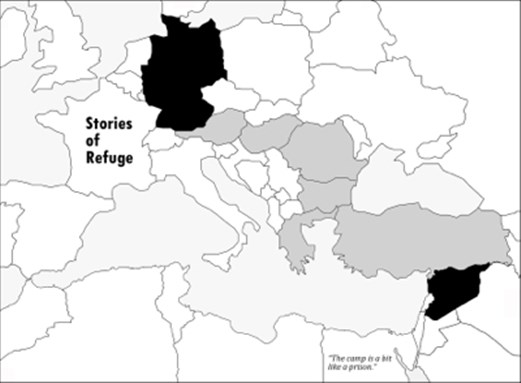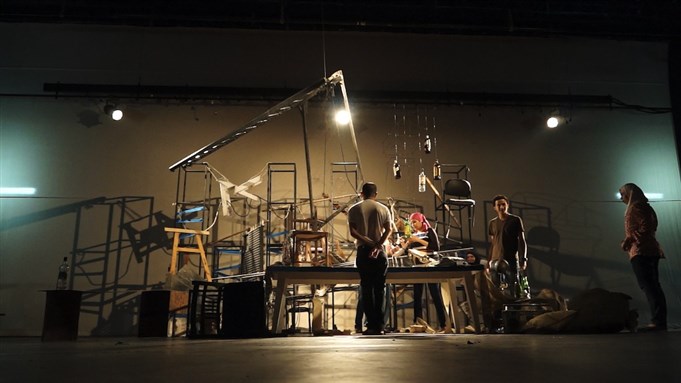In Munich recently, I found myself sitting in an Iraqi-owned café with three Syrian men. The first was a young businessman who spends much of his time, money, and energy helping Syrian refugees in Munich and sending aid to Syria. Second, there was a young poet who called himself “the poet of the revolution” and had several YouTube videos of him reciting his poems. The third person was a young man who just arrived in town, and was living in a “refugee camp” known as the “Yellow Camp.” The camp is actually a messy building with many small rooms where German authorities randomly group/house Syrian and non-Syrian refugees together. It literally serves as a systemic shock to people who for months dreamt of reaching Germany—the supposed land of the free, caring, and civilized. I was most interested in the story of the young man who had arrived to Munich. I wanted to give him a camera so he could film a day in his life living in the “refugee camp” in Munich. He seemed shy, did not want to jeopardize his residency application, and preferred to remain quiet. I assured him that his identity would remain confidential. He said that he worries about his parents who are still in Syria, and so chose to not participate.
The next day, I met a Kurdish Syrian man who was tortured by each of the Lebanese, Syrian, and Greek police because he happened to look like Hussam Hussam—a “false witness” in the international tribunal investigating the assassination of former Lebanese Prime Minister Rafik al-Hariri. It felt surreal to me that he manages to keep smiling and remain positive. He spends his time outside his normal working hours volunteering as a translator for Syrian refugees while putting human rights organizations in contact with various asylum seekers. Through him, I was introduced to three different individuals who would participate in what would become the Stories of Refuge project:
- a twenty-six-year-old man who has been in Munich for seven months but has not yet been granted residency;
- a sixteen-year-old boy who had just arrived in town and was hoping to be granted residency before he reaches the age of eighteen so he could use a family-reunification clause and bring his family to Munich;
- a twenty-five-year-old mother of two who had been in Munich for two months, initially lived with another randomly selected family in the Yellow Camp, and recently moved into a room exclusively for her family in what is referred to as the “temporary camp” while they wait for their residency papers and a transfer to long-term accommodations.
All three of these individuals had paid large amounts of money to be smuggled into Germany. They survived near-death experiences. One of them was injured during a demonstration in Syria, and fled the country by means of a boat that ended up sinking in the sea killing half of its passengers. One of them had to walk from Syria to Turkey for hours on end with children in hand, another young relative who was battling cancer, and no water. Smugglers scammed all of them, lying to them, suddenly changing plans, simply leaving them behind—never prioritizing their safety.
I gave each of the three participants a small discreet video camera that they smuggled into their camps, and asked them to film a day in their lives as asylum seekers in Munich. I also asked them to take us to their favorite spot in the city. I recorded an interview with each of them, which serves as the soundscape over the footage that they created.
The footage turned out to be erratic, the image jumpy. Although I had suggested a few “beauty shots” to the participants, none of them showed interest in such suggestions. They all ended up producing videos that look like the thousands of YouTube videos that came out of Syria since the start of the uprising—often filmed by ordinary people using phone cameras. The videos produced as part of the Stories of Refuge project are not only a recording of the participants’ oral histories, but also a representation of their own lives through their own lenses. Hiding their identity, the participants chose to represent their lives through their voices, their choice of material to shoot in their intimate spaces, and numerous intentional omissions. Some would film their feet while walking so as to place a part of themselves in the video. Some would keep themselves completely outside of the frame. It was particularly interesting to watch whether the interviewees would attempt to “dramatise” their already dramatic story, or whether they would sound like they have been repeating the same narrative over and over for a few months and thus by then have rehearsed their stories very well. Some of the interviewees asked me if I want “the official story, or the real one?” For them, what they called the “official story” had specific alterations in order to improve their chances of being granted residency in Germany.
In an audio interview, the voice recorder can often be forgotten, thus registering stories that the interviewees might not want to share publicly such as a revelation of domestic violence, admitting to cheating the legal system, naming the smugglers, and identifying family members. When this happened, the participants would invariably tell me what to edit out. When they felt that they had sidetracked the conversation from what they initially planned on telling me, they would simply demand, “delete this part.” In this project, I played the role of an editor. I am an amateur film editor as much as the participants are amateur filmmakers. The editing process was therefore also collaborative, and my choices were subject to the participants’ notes and ideas.
The Installation
On a busy road in Munich, the audience was invited to enter a shipping container where they found prison-like bunk beds. They each laid on a bed, placed headphones on, and watched one of the videos shot by the Syrian participants as it was projected on part of the wall in the container. A notebook was tucked under each of the pillows. The idea was for the audience to write down what they thought would happen to the characters in the videos and whether they had any advice for them. The audience’s notes and advice were touching, especially at a time when there is a debate in Munich, Germany, and Europe about “what to do with the Syrian refugees.
[An audience member sitting on the bunkbed and watching one of the videos. Image by Tana El Khoury]
The willingness of the participating Syrians to tell their stories and recall the horrendous experiences they have been living for the last three years while maintaining dignity, pride, and a sense of justice was inspiring. I remember one of the women I interviewed telling me: “We do not want sympathy. We want rights. Coming to Germany was never a dream for us. We are here temporarily. We want to work and learn because we are hard working people. Later on, we will back to our home and our country.”
One of the Videos
[Stories of Refuge was on display at the 2013 Spielart Festival in Munich Germany. Tania El Khoury and Petra Serhal, of Dictaphone Group, developed the project during a Cityworks residency.]







onMBC].png)









